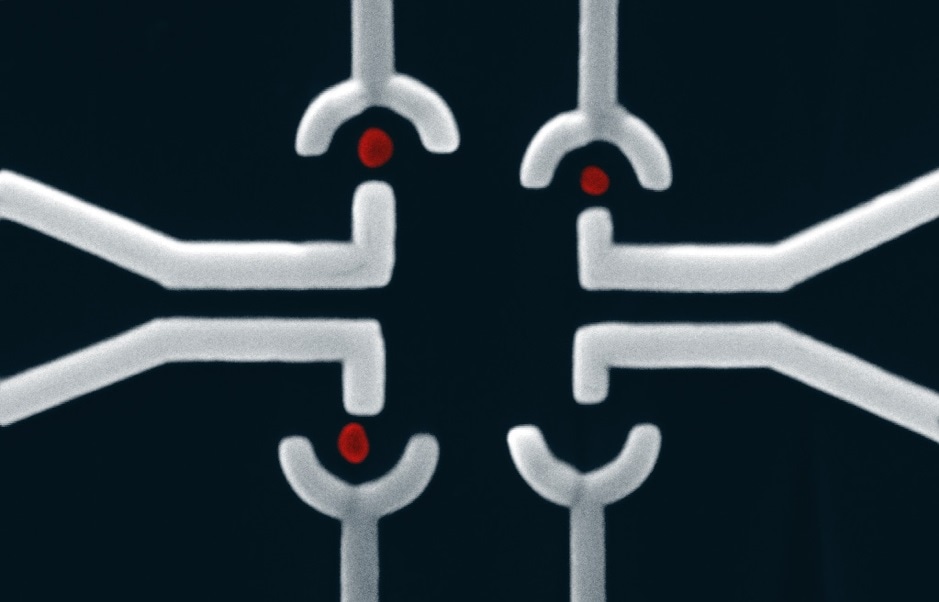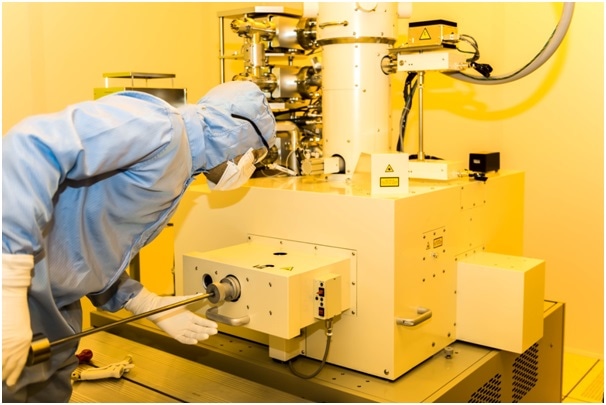Archer Materials is pleased to announce that the Company has progressed its pioneering quantum technology project 12CQ (pronounced “one two cee cue”) by assembling and patterning a nanometre-size array (“few-qubit array”) of several individual qubit material components (“qubits”) of a prototype room-temperature operating quantum computing qubit processor (“chip”).
 Fig. 1. Electron microscopy image of three isolated qubits (spherical shapes false-coloured in red-orange), positioned into an array on a silicon wafer surface, with each approximately 50 nanometres in size. Metallic control electrodes (false-coloured in grey-blue) aligned with nanoscale precision to the qubits. The width and height of the electrodes are comparable to the dimensions of the qubits, and compatible with modern electronic device features.
Fig. 1. Electron microscopy image of three isolated qubits (spherical shapes false-coloured in red-orange), positioned into an array on a silicon wafer surface, with each approximately 50 nanometres in size. Metallic control electrodes (false-coloured in grey-blue) aligned with nanoscale precision to the qubits. The width and height of the electrodes are comparable to the dimensions of the qubits, and compatible with modern electronic device features.
Commenting on the Company’s 12CQ developments, Archer CEO, Dr Mohammad Choucair, said: “This excellent achievement advances our chip technology development towards a minimum viable product, and strengthens our commercial readiness by providing credibility to the claim of 12CQ chips being potentially scalable [and therefore useful]. To build an array of a few qubits in less than a year means we are well and truly on track in our development roadmap taking us into 2020”.
12CQ Few-qubit Array Assembly
To assemble the few-qubit array of Archer’s chip, three individual qubits were isolated on a silicon wafer with metallic control electrode components (“electrodes”) aligned and deposited around the qubit array with nanoscale precision (“Process”) as shown in Fig. 1. The electrodes will allow for the measurement of quantum information stored on the individual qubits. The Process is possible due to a recent 12CQ chip development breakthrough of precision positioning of qubits (ASX Announcement 28 August 2019). The Process was carried out at room-temperature (Image 1).
The arrangement of the qubits was repeatable and reproducible, thereby allowing Archer to quickly build and test working prototypes of quantum information processing devices incorporating a number of qubits; individual qubits; or a combination of both, which is necessary to meet Archer’s aim of building a chip for a practical quantum computer. Further improvements and optimisation to the Process are likely to reduce the time required to build a working chip prototype.
The ability to build qubit arrays is a key requirement for developing a scalable and useful chip. To achieve this, Archer uses a unique carbon-based qubit that has the potential to enable chip operation at room-temperature and integration onboard modern devices (see Quantum Technology & Archer’s 12CQ Advantage). The qubit is the fundamental component of Archer’s 12CQ prototype chip, as without the qubit, quantum computing cannot be performed.
Commenting on the qubit array assembly, Archer CEO, Dr Mohammad Choucair, said: “A useful chip will need to have a number of qubits arranged in various patterns in order to run a number of algorithms, for example to perform transactions, secure communication, or in error-correcting quantum information processing.
“Today’s quantum computers have at best a few dozen qubits, so it is important we unambiguously showed the possibility of scaling our chip qubits early in development. With a few-qubit array we can advance to the next stages of development, which involve quantum information measurement”.

Image 1. Archer staff operating instrumentation within the Research and Prototype Foundry (“Foundry”) cleanroom used in the fabrication of chip prototypes at the University of Sydney (“University”). The yellow/orange light in the facility is not an image artefact, rather is a feature of the tightly regulated environment (temperature, humidity, and light) to mitigate the risk of the external environment destroying the fabricated devices.
Archer has commercial access to the Foundry, and the University is not involved in developing the 12CQ room temperature quantum computing chip technology. The 12CQ Project chip development is being completed by Archer’s own in-house team, led by CEO Dr Mohammad Choucair and Quantum Technology Manager, Dr Martin Fuechsle.
Next Steps
The technical development at the heart of 12CQ is a world-first. Archer intends to continue the technology de-risking, value-added development of the 12CQ qubit processor chip, by completing the next stages of component assembly and device measurements towards a proof-of-concept prototype chip. The prototype chip validation is required to establish a minimum viable product.
Archer intends to commercialise chip products through licencing and direct sales by seeking to establish commercial partnerships with highly resourced organisations including software developers and hardware manufacturers, that could allow for product scale, IP transfer, and distribution channels.
More information on Archer’s 12CQ Project commercial pathway can be found in ASX Announcement 30 October 2019.
Background and Market Summary
Quantum Technology & Archer’s 12CQ Advantage
Quantum computers represent the next generation of powerful computing. They consist of a core device (a chip) made from materials capable of processing quantum information (often called qubits) necessary to solve complex calculations. One of the biggest challenges to wide-spread use by consumers and businesses involves keeping the qubit stable at room-temperature while integrating into electronic componentry. The development of quantum computers is envisioned to impact industries reliant on computational power, including finance, cryptocurrency and blockchain.
During his previous employment at the University of Sydney, Archer CEO, Dr Mohammad Choucair, invented the first material known to overcome both the limitations of sub-zero (cryogenic) operating temperatures and electronic device integration for qubits. The conducting carbon material was able to process quantum information at room temperature and offered the potential for scalability: a solid-state material of workable dimensions for nanofabrication (less than 100 nanometres in size), easily processed and handled, and produced in quantities useful for quantum computing.
This unique combination of physical, chemical, and structural properties has the potential to reduce commercial barriers to quantum computing and make it globally accessible. The patented device incorporating these materials forms the subject of IP that was exclusively licenced from the University of Sydney by Archer (ASX Announcement 12 December 2018), and the materials are available in Archer’s wholly owned subsidiary Carbon Allotropes.
Market and Key Growth Catalysts
Australia forms a significant part of the growing quantum computing economy, however there are currently limited opportunities for on-market investment and exposure to financial returns from quantum computing technology. According to McKinsey, currently the highest-value in the quantum computing economy is derived from technology development in the US, EU, and Australia.
Morgan Stanley forecasts that quantum technology could double the value of high-end computers to US$10 billion by 2027. Investment bank Goldman Sachs predicts that by 2021, quantum computing could become a $US29 billion industry, while the Boston Consulting Group highlighted the dependence of the market size on achieving technical milestones over the coming decades.
Globally, quantum computing forms part of the mature semiconductor and electronic parts manufacturing industry (SEPMI). The SEPMI is a US$500 billion+ revenue market, with approx. 70% of manufacturing concentrated in Asia. Approximately 40% of costs in the market relate to materials, and the industry sees margins of approximately 10-20%. There are few companies with large market share including Samsung, Intel, and Qualcomm, giving rise to potential opportunities for mergers and acquisitions based on disruptive technology integration.